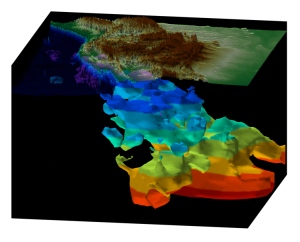Science News
The Wild West
April 8, 2013
by Molly Michelson

How was western North America formed? Geologists have long held that as North America broke away from Pangea and headed west, it ran into the Farallon plate. Subducted under the North American plate, the The Farallon acted almost like a conveyer belt, creating the extensive area of elevated topography that dominates the West—the coastal ranges, the Rocky Mountains and the high plateaus in between. This mountainous area consists of dozens of crustal blocks of varying age and origin, welded onto the American continent over the past 200 million years.
But something was missing in this explanation, says Karin Sigloch, of Ludwig Maximilian University in Munich. “How these blocks arrived in North America has long been a puzzle.”
So with colleague Mitchell Mihalynuk of the British Columbia Geological Survey, Sigloch went to work on the puzzle. The scientists used a technique called seismic tomography. Seismic tomography makes it possible to probe the geophysical structure of Earth’s interior down to the depth of the lower mantle by analyzing the propagation velocities of seismic waves. The method can image the remnants of ancient tectonic plates at great depths, revealing ocean floor that subducted a long time ago, disappearing from the surface and sinking back into the mantle.
The new data from their study suggest that the Farallon Plate was far smaller than had been assumed, and underwent subduction well to the west of what was then the continental margin of North America. The researchers also determined that there was likely another, previously unrecognized oceanic plate involved in the formation of the West.
As the North American plate moved westward, the initially met and consumed the previously unknown oceanic plate, now detected seismologically beneath east coast of modern North America. Only then did the continent begin to encounter the Farallon plate. On its westward journey, the scientists conclude that North America overrode one intervening island arc after another—annexing ever more of them for the construction of its wild, wide mountains of the West.
The study is published in this week’s Nature.
Image: Karin Sigloch